
HOME
INTRO
SYMBOLS
ALMANAC
ECONOMY
GEOGRAPHY
STATE MAPS
PEOPLE
FORUM
NEWS
COOL SCHOOLS
STATE QUIZ
STATE LINKS
BOOK STORE
MARKETPLACE
NETSTATE.STORE
NETSTATE.MALL
GUESTBOOK
CONTACT US


Tweet
Double click any word in document for definition.
Texas State Bread
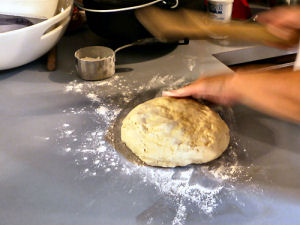
Texas State Bread: Pan de campo step 1
Pan de campo's, or cowboy bread's, march to officialdom was not without some argument. But probably not to the extent implied by this sub-heading from the Fort Worth Star-Telegram.
Bill pitching pan de campo is fightin' words to sourdough backers[1]
In fact, the discussion centered around a question that visits many a state symbol proposal. Is the proposed symbol a fitting representative of the entire state or does it hold only regional status?
Pan de campo was proposed as the state bread by State Represenative Ryan Guillen from Rio Grande City, a decidedly South Texas enclave on the border with Mexico. This is where the argument began.
Pro
Guillen said the bread has historical significance because it was eaten by cowboys who worked the vast ranches that defined early Texas, which would later give way to the economy we know today.
"It was the staff of life for the vaqueros," Guillen said.
(Pierson)
"Pan de campo enjoys a singular stature in Texas history and culture that is rivaled only by its undeniable appeal as a versatile and satisfying food," Guillen's resolution states, "and it is only right and proper that this essential element of the state's greatness receive official recognition."
(Chapman)
Con
Critics of the choice declared that pan de campo was a South Texas regional food, primarily a Mexican dish. They claimed that the most common bread found on the trail was sourdough bread. There were some that were rather adamant in their assertions that pan de campo would not be a good choice to represent all of Texas.
Whoa! say a host of cowboy cooks and Western historians. The flat bread was common in South Texas, but it was far from having "a singular stature."
"A cowboy moving north from South Texas finds pan de campo until he hits about 30 miles north of San Antonio, where it is replaced with biscuits or other bread," Calhoun said.
Cliff Teinert, an Albany rancher and bestselling chuck-wagon-cookbook author, said he's against pan de campo becoming the state bread. "That wouldn't be right," he said last week in Fort Worth. "Pan de campo is a regional speciality. It was popular along the border, but it shouldn't represent the whole state. The larger area used sourdough biscuits."
Red Steagall, a singer, songwriter, poet and Western historian, is steadfast in his assessment: "Sourdough bread is what went up the trail on the trail drives. Pan de campo is a Mexican dish."
Tom Perini, a prize-winning cookbook author, chuck-wagon cook and national spokesman for Pace Picante Sauce, said that the issue isn't clear-cut but that claiming pan de campo as the state bread "might be a stretch."
(Chapman)
In the end
Pan decampo became the official state bread of Texas when Governor Rick Perry signed House Concurrent Resolution No. 98 on June 18, 2005.
H.C.R. No. 98
HOUSE CONCURRENT RESOLUTION
WHEREAS, The colorful history of the Lone Star State is inextricably associated with the romance of cowboy culture, and among the many legacies of this proud heritage is the delicious flat bread known as pan de campo, or cowboy bread; and
WHEREAS, Relied on by early settlers and vaqueros to sustain themselves as they rode the range, pan de campo has transcended its humble origins to take a place of honor at such events as the Pan de Campo celebration that is sponsored annually by the San Diego Chamber of Commerce in Duval County; and
WHEREAS, With thousands of participants and spectators, the celebration includes such events as softball and volleyball tournaments, a parade and live Tejano music, and the pan de campo cook-off; and
WHEREAS, The chefs who make contemporary variations on pan de campo recognize that cowboy bread's appeal lies not only in its elegant simplicity but also in its role as a redolent reminder of the state's storied past and the vaqueros of South Texas; and
WHEREAS, Because the cowboys who introduced pan de campo to Texas had no access to conventional kitchens, the bread was prepared in small portable ovens, and it was this distinctive cooking method that gave pan de campo its characteristic texture and flavor; and
WHEREAS, Pan de campo enjoys a singular stature in Texas history and culture that is rivaled only by its undeniable appeal as a versatile and satisfying food, and it is only right and proper that this essential element of the state's greatness receive official recognition; now, therefore, be it
RESOLVED, That the 79th Legislature of the State of Texas hereby designate pan de campo the Official State Bread of Texas.
Guillen
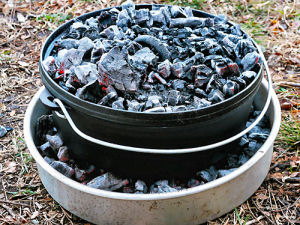
Texas State Bread: Pan de campo step 2
Texas Law
Pan de campo was adopted as the official state bread of the State of Texas by House Concurrent Resolution No. 98 and is, therefore, not listed in the Texas Statutes.
Only a small number of Texas' myriad symbols have been actually adopted by an act of the legislature and written into the Texas Statutes.
Sources...
"House Concurrent Resolution No. 98." The Texas Legislature Online. The State of Texas, 2911. Web. 2 Oct 2011. .
Pierson, Elizabeth. "Pan de campo proposed as official state bread." The Brownsville Herald. Freedom Communications, Inc., 20 Mar 2005. Web. 3 Oct 2011. .
Chapman, Art. "Food fight on for official bread of Texas." The Houston Chronicle. Hearst Communications, Inc., 27 Mar 2005. Web. 3 Oct 2011. .
Shearer, Benjamin F. and Barbara S. State Names, Seals, Flags and Symbols: A Historical Guide Third Edition, Revised and Expanded. Westport, Conn: Greenwood Press, 3 Sub edition, 2001.
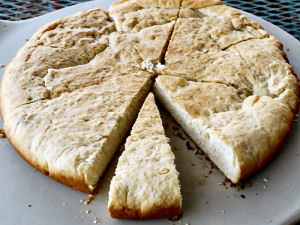
Texas State Bread: Pan de campo step 3
Additional Information
Exploring the Tejano Origins of the State Bread of Texas: Texas Historical Commission
Pan de Campo: The Official State Bread of Texas: Traditional Texas Food: Articles about Texas' most famous foods by John Raven, Ph.B.
Pan de campo (camp bread): "Texas Highways," the travel magazine of Texas.
Rio Grande City: Official website.
State foods: Complete list of official state foods from NETSTATE.COM.
More symbols & emblems: Complete list of official Texas state symbols from NETSTATE.COM.
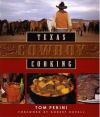
Texas Cowboy Cooking
Tom Perini
Texas Cowboy Cooking, by Tom Perini. 192 pages. Publisher: Comanche Moon Pub; Revised edition (September 2001) Texas Cowboy Cooking collects Tom Perini's all-time favorite recipes for mouth-watering Texan food and drinks. Perini also shares his award-winning tips preparing them, including his secrets to cooking the perfect steak - for selecting the cut, preparing it, knowing when to turn it, and when to call it done. Throughout, stunning photography, archival illustrations, and Perini's own dry, Texan wit bring to life the romance, adventure, character, and humor of life in cowboy country.
Buffalo Gap, Texas, the very heart of cowboy country and home to Tom Perini, one of the most sought-after restaurateurs and cooks of authentic Texan food in the world. Perini has cooked ("I'm not a chef") traditional fare in the kitchens of the James Beard House, at the governor's mansion for George W. Bush, and - as official representative of the Texas Beef Council - from the back of his chuckwagon in Japan. His restaurant's peppered beef tenderloin was ranked the #1 direct-mail gift in the country by the New York Times.
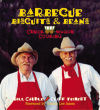
Barbecue, Biscuits & Beans
Barbecue Biscuits & Beans: Chuck Wagon Cooking, by Bill Cauble and Cliff Teinert. 192 pages. Publisher: Bright Sky Press (September 1, 2002) Chuck wagon cooks Bill Cauble and Cliff Teinert look as though they have stepped out of the pages of Lonesome Dove, and the foreword by Tommy Lee Jones speaks to the authenticity of their chuck wagon cooking and Southwestern cuisine. These authors share recipes and preparation secrets for their all-time favorite dishes—trail-side to elegant—featuring a bounty of beef and game, vegetables from beans, tomatoes, and squash to hominy, homemade breads, and delectable desserts.
"Adaptable and inventive, sumptuous and wholesome" is their goal—and achievement—as they use available ingredients and leftovers in developing meals and menus to please all tastes. Photography by Watt Casey, Jr., captures the colors of genuine cowboy life alongside full color displays of the finished dishes—and preparations.

